Use of Federal Reserve Programs - 08/26/2020
Below we report on operational Fed programs, based on the Fed’s weekly H.4.1 release. Since last week, the Reserve Bank of Australia and Bank of Korea have ceased their use of the Fed’s swap lines. The use of lending facilities has declined to $ 98.4 billion.
As of August 26, the Fed’s liquidity programs had $98.5 billion in outstanding loans. The outstanding has decreased by approximately 6.5% compared to the end of July (see the post here).
Figure 1 below shows the outstanding amount of each facility, not including Treasury contributions that are invested in securities rather than loans to market participants.
On July 29, the Federal Reserve announced the extensions of its temporary U.S. dollar liquidity swap lines and the temporary repurchase agreement facility for foreign and international monetary authorities (FIMA repo facility). Now, these facilities are set to expire on March 31, 2021 (see our blog post here). These deadline extensions follow the extensions of other lending programs to December 31, as announced on July 28. The Fed had previously extended the termination date for the Municipal Lending Facility in April.
Note on Treasury Contributions to Federal Reserve Programs
The Treasury announced on April 9 that it intended to use funds available under the CARES Act to purchase equity in special purpose vehicles established under Fed lending programs.
In total, the Treasury has invested $114 billion in six facilities, as of August 26, unchanged from July 22. Per the facility agreements, 85% of the equity contributions to the CCF, CPFF, MLF, MSF, and TALF have been invested in nonmarketable Treasury securities: $31.9 billion for the CCF, $8.5 billion for the CPFF, $14.9 billion for the MLF, $14.9 billion for the MSF, and $8.5 billion for TALF.
Note on the Municipal Lending Facility
According to Bloomberg, the Fed purchased $451 million of notes sold by New York’s Metropolitan Transportation Authority (MTA), charging an interest rate of 1.92%. This purchase increased the outstanding MLF loans from $1.20 billion to $1.65 billion. MTA was second to tap the MLF after the state of Illinois. This was also the first purchase after the Fed’s announcement (see our related blogpost here) to lower pricing for the MLF.
Note on Federal Reserve Swap Lines
Over the past month, central banks continued to reduce their use of the Fed’s USD swap lines. The reduction is partially due to the expiration of 84-day swaps entered during the early weeks of the crisis. Auctions for these swaps were conducted weekly. As these contracts are reaching maturity, the total outstanding amount declined. As of August 26, the total amount still outstanding is $89 billion, down by 24.7 percent since the end of July.
Over the past month, the Reserve bank of Australia and Bank of Korea reduced their outstanding amount, and these two central banks no longer has outstanding USD swaps with the Fed. At $89 billion outstanding, the BoJ’s share now represents 81.7% of the total.
BOE, BOJ, ECB, and the Swiss National Bank, in consultation with the Federal Reserve, have jointly decided to further reduce the frequency of their 7-day operations from three times per week to once per week (BOE’s press release here). This reflects the low demand for recent 7-day maturity US dollar liquidity providing operations.
On August 19, ECB published at blog post analyzing the use of swap lines, explaining how swap lines improved market sentiment and contributed to reduce the cost of dollar funding.
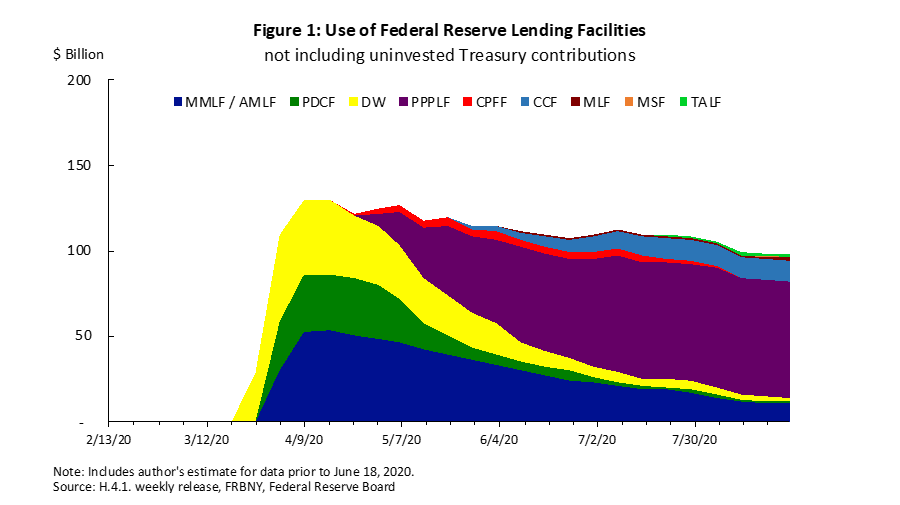
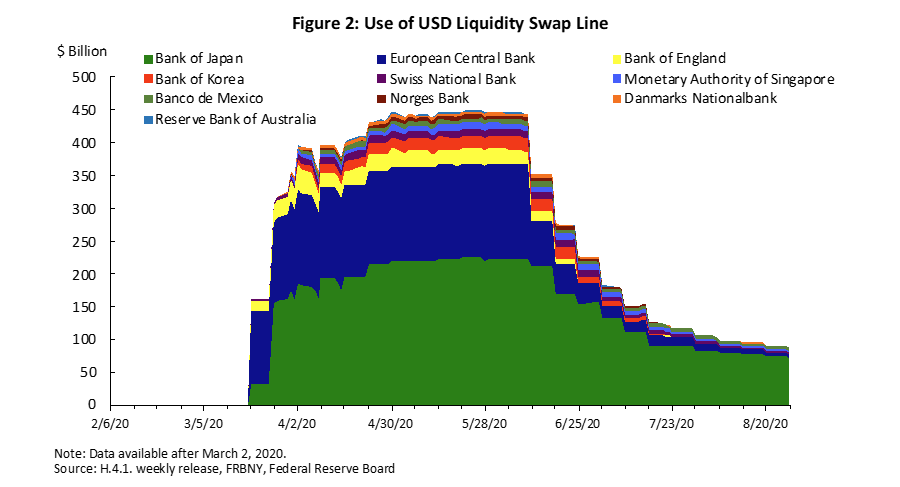 The following figures show the usage of Fed programs during the COVID-19 crisis. They also show data for similar programs during the Global Financial Crisis of 2007-09 (GFC), where applicable. The new graphs also indicate how soon each program was launched relative to the start date of recessions (February 1, 2020, for COVID, and December 1, 2007 for GFC). The actual take-up of these facilities has been relatively low compared to the take-up of similar facilities during the GFC.
The following figures show the usage of Fed programs during the COVID-19 crisis. They also show data for similar programs during the Global Financial Crisis of 2007-09 (GFC), where applicable. The new graphs also indicate how soon each program was launched relative to the start date of recessions (February 1, 2020, for COVID, and December 1, 2007 for GFC). The actual take-up of these facilities has been relatively low compared to the take-up of similar facilities during the GFC.
For a more detailed comparison of Fed programs during the GFC and the COVID-19, see our Key Program Summaries.
Liquidity Swap Lines
The USD swap lines are bilateral agreements between the Fed and foreign central banks. They allow foreign central banks to exchange domestic currency for US dollars. The Fed currently maintains swap line agreements with 14 central banks.
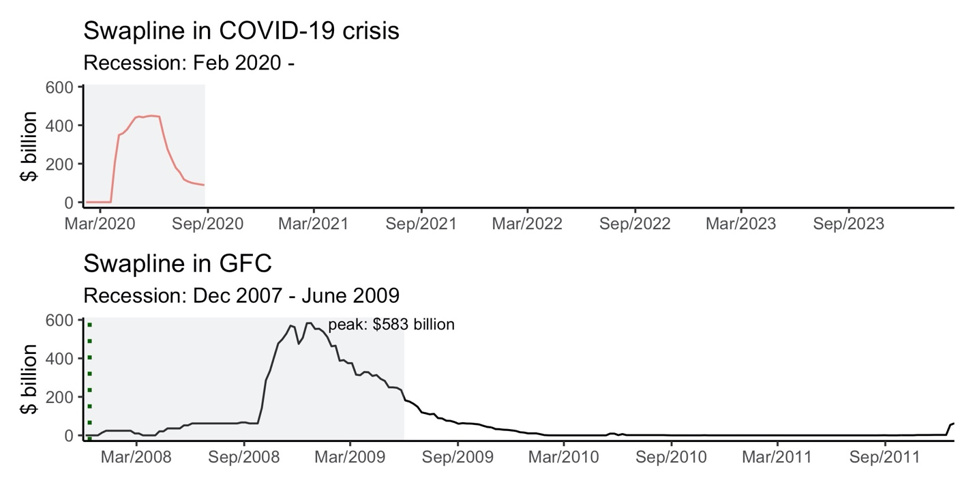
 Money Market Mutual Fund Liquidity Facility
Money Market Mutual Fund Liquidity Facility
The MMLF allows the Fed to fund the purchase of money market mutual fund assets. The program is established under section 13(3) of the Federal Reserve Act. The Fed reported that the U.S. Treasury, to date, has provided credit protection of $1.5 billion to the Money Market Mutual Fund Liquidity Facility. The facility had $10.0 billion in outstanding loans on August 26. It is similar to the Asset-Backed Commercial Paper Liquidity Money Market Mutual Fund Liquidity Facility (AMLF) that the Fed launched during the GFC. The AMLF funded the purchase of ABCP from MMFs. In comparison, the MMLF is authorized to purchase a broader range of collateral.
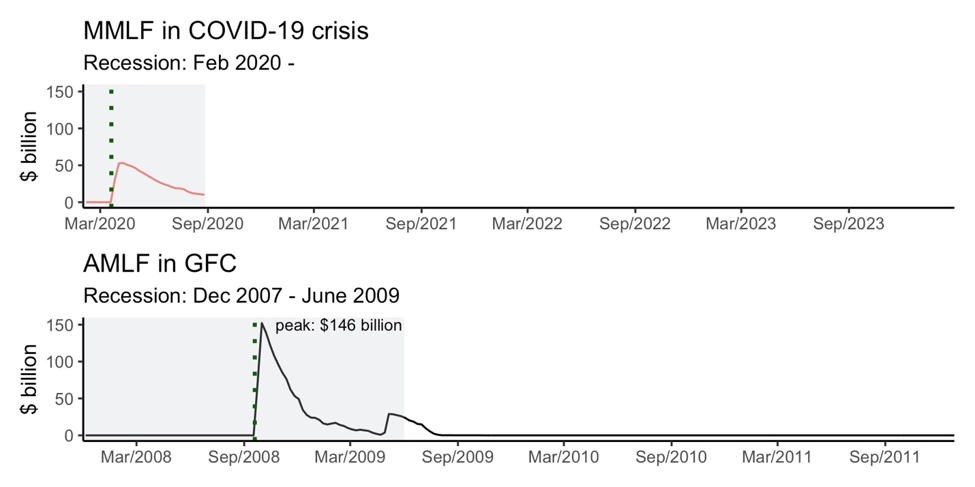
 Discount Window
Discount Window
The DW is a standing facility that allows the Fed to provide collateralized loans to depository institutions. It had $2.7 billion in outstanding loans on August 26.
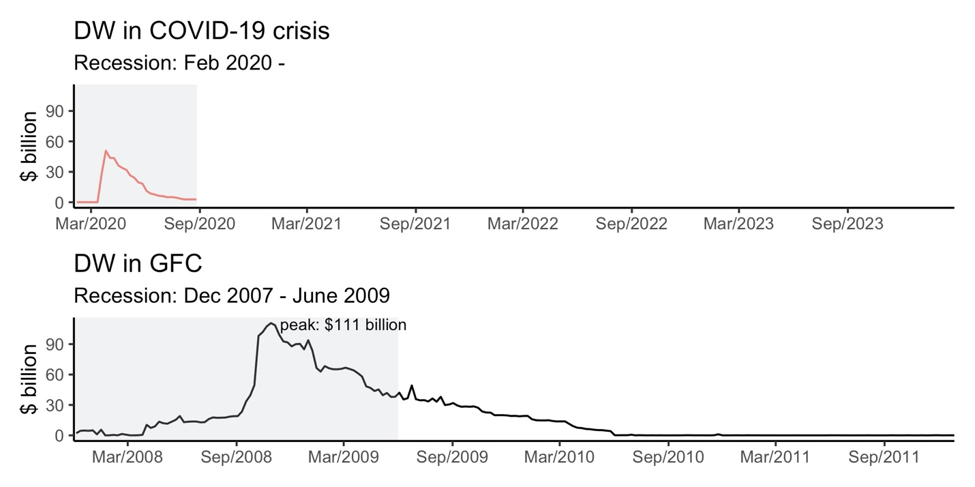
 Primary Dealer Credit Facility
Primary Dealer Credit Facility
The PDCF allows the Fed to extend collateralized loans to primary dealers. The facility was established under section 13(3). The facility had $243 million in outstanding loans on August 26.
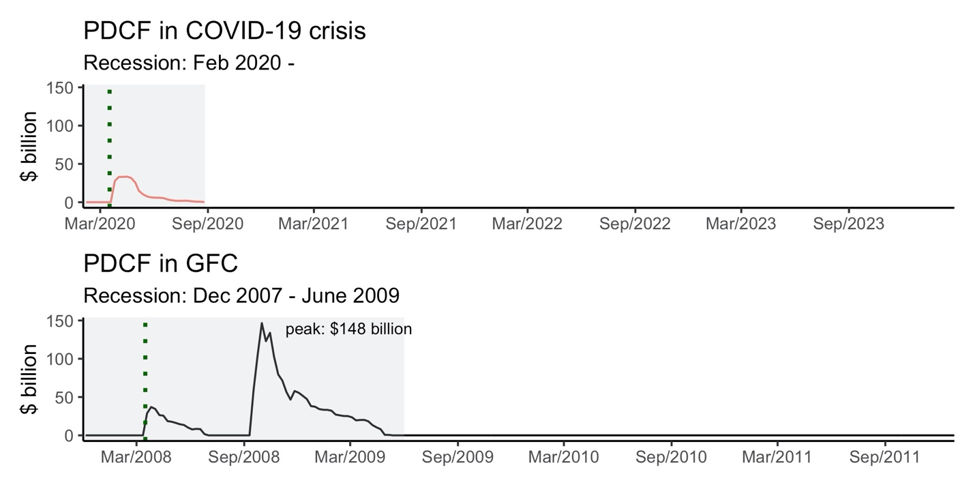
 Paycheck Protection Program Liquidity Facility
Paycheck Protection Program Liquidity Facility
The PPPLF allows the Fed to provide financial institutions with liquidity backed by loans to small and medium-sized businesses extended under the federal government’s Paycheck Protection Program and guaranteed by the Small Business Administration. The Program was established under section 13(3). The facility had $68.2 billion in outstanding loans on August 26.

 Commercial Paper Funding Facility
Commercial Paper Funding Facility
The CPFF provides a liquidity backstop to issuers of commercial paper and was also established under section 13(3). It is operated by the FRBNY through a special purpose vehicle, the Commercial Paper Funding Facility II LLC (CPFF LLC). The Treasury has made an equity investment of $10 billion in CPFF LLC. The facility had $30 million in outstanding loans on August 26.
Primary and Secondary Market Corporate Credit Facilities
The PMCCF and SMCCF were set up under section 13(3) to support credit to employers through purchases of newly issued bonds and support market liquidity for outstanding corporate bonds. These facilities operate through a special purpose vehicle, the Corporate Credit Facilities LLC (CCF LLC). The Treasury has made an equity investment of $37.5 billion in CCF LLC. The facilities had $12.6 billion in outstanding loans on August 26.
Municipal Liquidity Facility
The MLF provides liquidity to states, counties and cities. The facility was set up to purchase up to $500 billion of short-term notes and was established under section 13(3). The Treasury has made an equity investment of $17.5 billion in MLF LLC. The facility had $1.7 billion in outstanding loans on August 26.
Main Street Lending Programs
The MSF is established under section 13(3) to provide loans to SMEs. The program operates through three facilities: the Main Street New Loan Facility (MSNLF), the Main Street Priority Loan Facility (MSPLF), and the Main Street Expanded Loan Facility (MSELF). The loans are extended through a special purpose vehicle, the Main Street Facilities LLC (MSF LLC), established by the Federal Reserve Bank of Boston. The Treasury has made an equity investment of $37.5 billion in MSF LLC. The facility had $855 million in outstanding loans on August 26.
Term Asset-Backed Securities Loan Facility
The TALF is established under section 13(3) to provide liquidity guaranteed by asset-backed securities (ABS). Under the facility, the Federal Reserve lends to holders of certain AAA-rated ABS. The facility operates through a special purpose vehicle to extend its loans, the Term Asset-Backed Securities Loan Facility II LLC (TALF II LLC). The Treasury has made an equity investment of $10 billion in TALF II LLC. The facility had $2.3 billion in outstanding loans on August 26.
Summary Table from our Key Program Summaries

